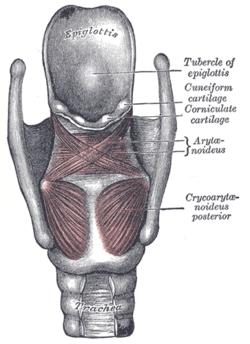| Epiglottis | |
|---|---|
 View of the larynx from behind. The epiglottis is the structure at the top of the image. | |
| Details | |
| Precursor | Fourth pharyngeal arch[1] |
| Function | Prevent food from entering the respiratory tract |
| Identifiers | |
| Latin | epiglottis |
| Greek | ἐπιγλωττίς |
| MeSH | D004825 |
| TA98 | A06.2.07.001 |
| TA2 | 3190 |
| FMA | 55130 |
| Anatomical terminology | |
The epiglottis (pl.: epiglottises or epiglottides) is a leaf-shaped flap in the throat that prevents food and water from entering the trachea and the lungs. It stays open during breathing, allowing air into the larynx. During swallowing, it closes to prevent aspiration of food into the lungs, forcing the swallowed liquids or food to go along the esophagus toward the stomach instead. It is thus the valve that diverts passage to either the trachea or the esophagus.
The epiglottis is made of elastic cartilage covered with a mucous membrane, attached to the entrance of the larynx. It projects upwards and backwards behind the tongue and the hyoid bone.
The epiglottis may be inflamed in a condition called epiglottitis, which is most commonly due to the vaccine-preventable bacterium Haemophilus influenzae. Dysfunction may cause the inhalation of food, called aspiration, which may lead to pneumonia or airway obstruction. The epiglottis is also an important landmark for intubation.
The epiglottis has been identified as early as Aristotle, and gets its name from being above the glottis (epi- + glottis).